Digital transformation for not-for-profits
It has never been more important to build a digitally capable, highly skilled and resilient not-for-profit sector. The last few years have shown us how powerful digital transformation can be in helping not-for-profits (NFPs) deliver impact and be more responsive to the needs of their communities.
GWI has deep experience working in the NFP sector to uplift digital technology capabilities. We have seen, first-hand, the positive impacts of a digitally capable workforce on delivering positive outcomes for their communities. And yet, in some cases, there is a distinct lack of training and confidence among NFP staff when it comes to using technology and IT systems.
With the unique challenges of the NFP sector, the need for greater impact and efficiency further drives the urgency for digital transformation.
The digital transformation hierarchy of needs for NFPs
The digital transformation hierarchy of needs for not-for-profits outlines our useful approach to ensure a successful digital transformation journey. Devised by Ian Roderick, GWI Partner and CEO of gwi.digital, the hierarchy clearly establishes the foundations of a successful digital transformation project with consideration to the unique needs and challenges some NFPs face on the journey.

1. Does the wi-fi work?
That might be overly simplistic, but the foundation of a digital transformation program is actually the basics like email works, wi-fi in the office is decent, and connectivity to branches or regional areas doesn’t drop out all the time.
If you can’t get the basics right, why would you be trusted to do more complex changes?
2. Do we need a hammer or a screwdriver?
You are likely going to need to make choices about what technologies you are going to use. Do you get something tailored to your specific needs or do you use something more general and build out the solution yourself?
Don’t rush this step, if it feels wrong, it probably is. Make sure you have good contracts and commercial agreements, especially for services.
3. Is everyone on the bus? And that includes the driver
The person driving the bus almost always needs to be the CEO. If this isn’t one of the organisation’s top three priorities, then don’t do it.
Active leadership from the CEO is one of the biggest factors in determining success in digital transformation. After that, take the time to explain what is happening and why. Formal organisational change management and communications is worth the investment.
4. Do you trust your reports?
Lose focus on data at your peril. Data is the fuel that powers your digital aspirations.
It isn’t practically possible to start too early or put too much effort into getting (and keeping) your data right and making sure the new shiny systems are capturing and giving you the information you need.
5. Are we better at what we do?
The ultimate goal is to use digital technology to better serve your clients and stakeholders.
Focus on improving service delivery, this could mean doing things entirely differently because of what the technology enables you to do.
Hold yourself to account by tracking and measuring the improvements that have been made. You have done the hard work, spent the money, and lost the sleep, have the evidence to show that it was all worth it.
Digital transformation is no small feat.
It is a significant investment in time and resources. This hierarchy of needs considers the entire journey and reminds NFPs of the fundamentals of a successful digital transformation program.
Looking to the future of digital transformation in NFPs, the top priorities for the years to come will be uplifting the digital capabilities of staff and improving data and information security. But these can only be achieved with good digital and technology foundations.
GWI CEO, Neil Makepeace is Board Chair of Autism Queensland. GWI is proud to have done meaningful work in the NFP sector since 2009. Talk to the team if you’d like to know more about how our expertise in digital transformation can deliver lasting value for your organisation.




